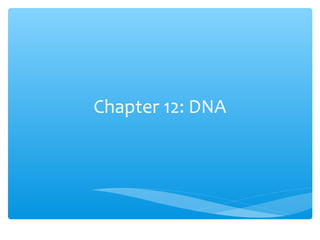
Notes ch12 DNA
- 2. ∗ DNA has 3 functions: ∗ Storing information ∗ Copying information ∗ Transmitting information 12.1 The Role of DNA
- 3. ∗ DNA – deoxyribonucleic acid ∗ Nucleotides – monomers that make up a DNA molecule ∗ 3 parts: ∗ 5 Carbon sugar (deoxyribose) ∗ Phosphate group ∗ Nitrogenous base ∗ Adenine (A) ∗ Guanine (G) ∗ Cytosine (C) ∗ Thymine (T) 12.2 The Structure of DNA
- 4. ∗Edwin Chargaff (1949) ∗Chargaff’s Rule ∗[A]=[T] ∗[C]=[G] Solving the Structure of DNA Adenine Thymine Guanine Cytosine 35% 45%
- 5. ∗ Rosiland Franklin used X-ray diffraction to visualize DNA structure (1952).
- 6. ∗ Watson and Crick were the first to model DNA as a double helix in 1953.
- 7. ∗ All the previous discoveries show us the structure of DNA and how DNA can function as a carrier of genetic information. ∗ Characteristics of the double helix model: ∗ Antiparallel strands ∗ Hydrogen Bonding ∗ Base Pairing The Double Helix Model
- 8. Antiparallel Strands ∗Run in opposite directions Base Pairing ∗Bases are held together by hydrogen bonds. Base Pairing ∗A bonds with T, and C bonds with G ∗ Complimentary base pairs hydrogen bond covalent bond
- 9. ∗ If the sequence of bases on one strand of a DNA molecule is TCGAACTGA, the sequence on the other (complimentary) strand is: Practice Base Pairing
- 10. ∗ Why does DNA replicate? (Hint: Think back to Mitosis) ∗ DNA is replicated in the S phase of the cell cycle, before the cell divides. 12.3 DNA Replication
- 11. ∗ Step 1 ∗ The DNA double helix unwinds ∗ DNA helicase (enzyme). ∗ breaks the H bonds between the bases. ∗ The areas where the double helix separates are called replication forks. Copying the Code
- 12. ∗ Step 2 ∗ DNA polymerase (enzyme) moves along each DNA strand adding complimentary bases according to the base pairing rules. ∗ DNA polymerase also proofreads the DNA molecule to reduce errors.
- 13. ∗ Step 3 ∗ The process continues until all of the DNA has been copied. ∗ DNA polymerase detaches.
- 14. ∗ This process produces two DNA molecules each composed of one new and one original strand. ∗ Both DNA molecules produced are identical to each other. ∗ DNA replication takes place at many points on a eukaryotic chromosome. ∗ Allows replication to happen more quickly.